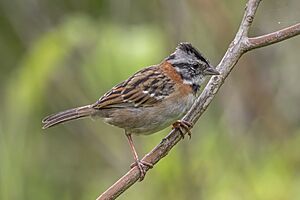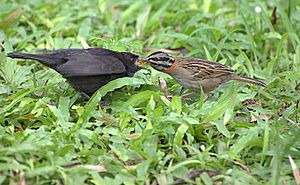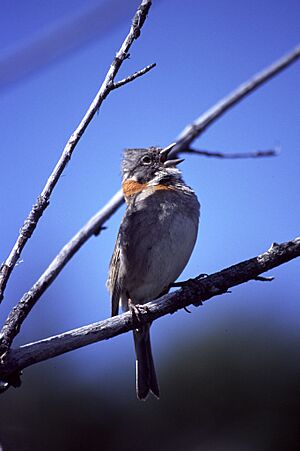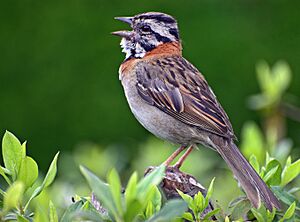Rufous-collared sparrow facts for kids
Quick facts for kids Rufous-collared sparrow |
|
|---|---|
 |
|
| Zonotrichia capensis costaricensis, Panama | |
| Conservation status | |
| Scientific classification | |
| Genus: |
Zonotrichia
|
| Species: |
capensis
|
 |
|
| Range of Z. capensis | |
The rufous-collared sparrow (Zonotrichia capensis), also known as the Andean sparrow, is a small bird found in many different places. You can spot it in various habitats, often close to people, from the very south-east of Mexico all the way down to Tierra del Fuego in South America. It also lives on the island of Hispaniola in the Caribbean.
This sparrow is famous for its many different songs and calls, which scientists have studied for a long time. People in different countries have special names for it, like tico-tico in Portuguese, copetón (meaning "tufted") in Colombia, and chingolo or chincol in other Spanish-speaking areas. In Costa Rica, it's sometimes called comemaíz which means "corn eater."
Contents
Appearance and Types
The rufous-collared sparrow is about 13.5–15 cm (5+1⁄4–6 in) long and weighs around 20–25 g (0.71–0.88 oz). Adult birds have a short, grey beak and a grey head. They have wide black stripes on the sides of their head and thinner stripes through their eyes and below their cheeks.
One of their most noticeable features is the reddish-brown (rufous) color on their neck and the sides of their chest, which looks like a collar. Their back is brownish with black streaks. They also have two white bars on their wings. Their throat is white, and their belly is off-white, turning brown on the sides. They also have a black patch on their chest.
Young sparrows look a bit different. Their head patterns are not as clear, with brown stripes instead of black, and a buff color instead of grey. They also don't have the rufous collar and their undersides are streaked.
There are many different types, or subspecies, of the rufous-collared sparrow, about 25 to 29 of them! Generally, the smaller types live in coastal mountains, while medium-sized birds are found in the Andes mountains. Larger, darker types live on high, flat-topped mountains called tepuis.
Where They Live
This bird is very common and can be found in many places. In the northern and western parts of its range, it usually lives at high altitudes, from 600–4,000 m (2,000–13,100 ft) above sea level. But in the southern and eastern areas, you can find it closer to sea level.
The rufous-collared sparrow can live in almost any open or partly open area. This includes farms, gardens, parks, grasslands, and areas with new plant growth. They do well in cities and suburban neighborhoods. However, they don't live in the thick forests of the Amazon Basin. They are also rare in the Guiana Shield, except for some tepuis and the Pakaraima Mountains in Guyana.
It's thought that this species used to live in more places in the Caribbean during the last ice age, when it was much colder. As the Earth warmed up, they became isolated in the highest mountains of Hispaniola. They are also found on Aruba and a few other Caribbean islands.
What They Eat
The rufous-collared sparrow looks for its food on the ground. It eats seeds, fallen grains, insects, and spiders. Sometimes, they join groups of different bird species that are feeding together. They have even been seen picking termites from spider webs!
These birds are usually seen in pairs that protect small areas, or in small groups. They are quite tame and easy to approach. Because they are common throughout their large range, they are not considered to be in danger by the IUCN.
Reproduction and Life Cycle

The breeding time for these sparrows depends on when food is available, which is usually linked to rainfall. In the subtropical areas of north-west Argentina, females start building nests around late October when the rainy season begins. Most nesting is finished by early December. However, in the Andes of Ecuador, eggs were being incubated in December, and nest-building was seen in March and April, suggesting they breed throughout the wet season.
Their nest is shaped like an open cup and is made of plant material lined with fine grasses. They build it in thick plants on the ground, low in a tree or bush, or even in a small space in a wall. Nests are usually less than 0.5 m (1.6 ft) high, but can sometimes be up to 2 m (6.6 ft) high.
The female lays two or three pale greenish-blue eggs with reddish-brown spots. Each egg is about 19–21 mm (0.75–0.83 in) long and 15–16 mm (0.59–0.63 in) wide, weighing about 2.6–2.8 g (0.092–0.099 oz). The female sits on the eggs for 12–14 days. During this time, she spends about two-thirds of the day on the nest. The male helps by feeding the chicks, which stay in the nest for about two more weeks. They don't eat a lot, and even when they are almost ready to leave the nest, their parents only feed them about every 10 minutes.
Sometimes, other birds, like the shiny cowbird (Molothrus bonariensis), will lay their eggs in the sparrow's nest, a behavior called brood parasitism. It's also common for nests to fail during the egg incubation period because of predation (when other animals eat the eggs). However, young sparrows in the nest don't seem to be eaten by predators more often than other similar-sized birds.
How Their Bodies Work
Adapting to Salt and Water
The rufous-collared sparrow uses its kidneys to control the amount of salt and water in its body. It can handle different amounts of salt, even though it doesn't have a special gland that helps birds get rid of extra salt. However, it takes a lot of energy for their bodies to do this, so they usually don't live in very salty places like salt marshes. If they eat more salt, their kidneys and heart can grow up to 20% bigger! This makes their body use up to 30% more energy just to stay alive. The size of their kidneys also changes depending on how much water is in their environment. In dry places, their kidneys tend to be smaller because they make very concentrated urine.
Adapting to Temperature
Since these sparrows don't migrate (move to warmer places for winter) and live in many different elevations, they experience big temperature changes throughout the year. To deal with this, they have ways to adapt. They can control how much water they lose through evaporation, and they can increase how fast their body uses energy. They lose more water through evaporation in summer to stay cool and less in winter. When it's cold, their bodies use more energy to stay warm.
Adapting to High Altitudes
Because rufous-collared sparrows live at many different heights, their bodies have adapted in special ways. Birds living at high altitudes have certain genes in their muscles that work harder. These genes help with how their body uses energy and sends signals. This adaptation is flexible; if high-altitude birds are brought to a lower elevation, these gene differences disappear. Studies also show that birds from both low and high elevations react similarly to low oxygen, but high-altitude birds are better at handling cold temperatures.
Their Songs and Calls
The rufous-collared sparrow has many different songs and calls depending on where it lives. One common call is a sharp tsip. The male's song, sung from a low branch or perch, often includes smooth whistles, sometimes with a fast trill at the end, like tee-teeooo, e’e’e’e’e, or teeooo, teeeee.
In many places, especially in Argentina, their songs usually have two parts:
- An introduction with two to four clear whistles. These whistles can be flat, go up, go down, or go up then down in pitch.
- A final trill, which is made of many similar, fast sounds.
Each bird usually sings the same song over and over. The speed of the trill changes a lot between different groups of birds.
These songs are typically about 2 to 2.5 seconds long. The whistle notes are about 0.25 to 0.5 seconds each. Most of the sound energy in these notes is between 4 and 6 kHz. The trill sounds are usually descending (going down in pitch).
Singing Habits: Individual sparrows can sing for up to 30 minutes, but usually sing for 2–5 minutes. They often sing from a high spot like a rock, bush, or even a wall or shed in suburban areas. They tend to have favorite singing spots that they use repeatedly. Sometimes, they sing while flying, especially when migrating. These "flight songs" seem longer and more complex than their usual songs. They also sing at night sometimes, though this is rare and might happen when they are stressed. Night songs are usually longer and more complex than daytime songs.
While they sing most actively around dawn, they will sing strongly at almost any time of day during their main breeding season (September to January), unless it's very hot (above 30 °C (86 °F)). There's a small increase in singing activity in the evening too.
Song Differences
In some dry areas, like parts of Argentina and Costa Rica, the sparrows might not have a trill at the end of their song; it's just whistles. A few birds in certain mountain grasslands might even have two trills.
Female sparrows don't seem to sing, but scientists aren't completely sure.
In the most studied groups, like those in north-west Argentina, most birds sing only one very specific song, and it doesn't seem to change over the years. However, in tropical areas like Ecuador, individual birds might have a collection of up to seven different song types.
Vocal Dialects
The rufous-collared sparrow is a great example of how bird songs can change based on their habitat. Scientists noticed over 30 years ago that the songs varied a lot geographically. They found that the way songs changed was closely linked to different types of habitats. For example, the trill part of the song was often fast in open grasslands and slower in woodlands and forests.
This idea, called the Acoustic Adaptation Hypothesis, suggests that birds' songs adapt to their environment to be heard better. Studies have shown that these song patterns are very stable over time, lasting for decades. This means that even if the original plants are removed for farming, the birds in that area might still sing the song that was best suited for the old habitat.
However, recent research suggests that tropical populations in Ecuador don't follow this pattern. Instead, individual birds there have many different trill types in their songs, and a single local group can have as much song variety as all of Argentina!
See also
- Tico-Tico no Fubá





